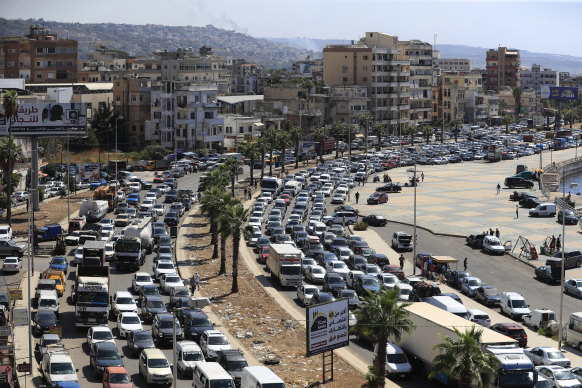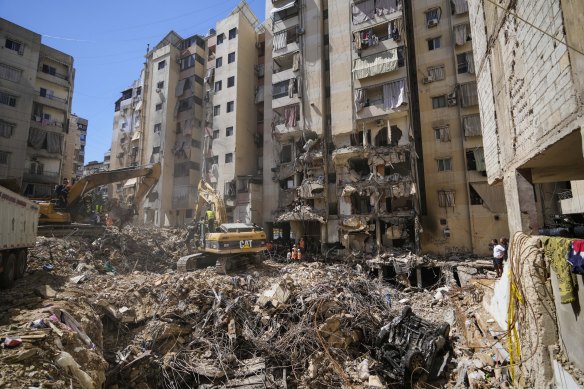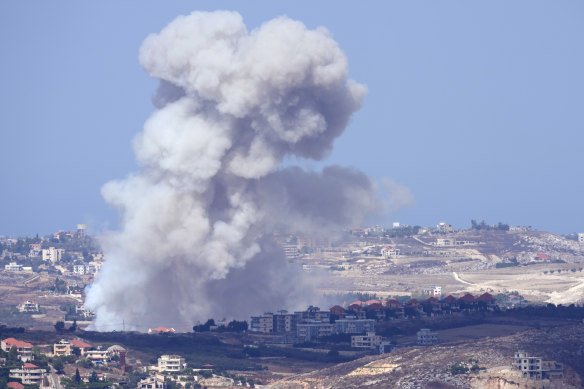This was published 10 months ago
US sends troops to Middle East after Israeli strikes in Lebanon kill hundreds
By Tara Copp and Bassam Hatoum
Jerusalem/Beirut: The US is sending additional troops to the Middle East in response to a sharp spike in violence between Israel and Hezbollah forces in Lebanon that has raised the risk of a greater regional war, the Pentagon said.
A Pentagon spokesman would not say how many more forces would be deployed or what they would be tasked to do. The US now has about 40,000 troops in the region.
The aircraft carrier USS Harry S. Truman, two Navy destroyers and a cruiser set sail from Norfolk, Virginia, have now departed to the Sixth Fleet area in Europe on a regularly scheduled deployment, opening up the possibility the US could keep both the Truman and the aircraft carrier USS Abraham Lincoln, which is in the Arabian Gulf, in the region in case more violence breaks out.
“In light of increased tension in the Middle East and out of an abundance of caution, we are sending a small number of additional US military personnel forward to augment our forces that are already in the region,” Major General Pat Ryder said. “But for operational security reasons, I’m not going to comment on or provide specifics.”
It comes after Israeli forces struck multiple targets inside Lebanon killing 492 people, according to the Lebanese Health Ministry, including 35 children and 58 women, and wounding 1645, and as Israel prepares for “further operations”.
One Lebanese official said it was Lebanon’s highest daily death toll from violence since the 1975-1990 civil war.
On Monday, Israel warned people in Lebanon to evacuate areas where it said the armed militant group Hezbollah was storing weapons.
The warning caused thousands of people to panic and flee southern Lebanon towards the north, generating hours-long traffic jams on all major roads.

Cars sit in traffic as they flee the southern villages amid ongoing Israeli airstrikes, in Sidon, Lebanon.Credit: AP
Nasser Yassin, the Lebanese minister co-ordinating the crisis response, said 89 temporary shelters in schools and the like had been activated, with capacity for more than 26,000 people as civilians fled “Israeli atrocities”.
Israeli Prime Minister Benjamin Netanyahu sent a short video statement addressed to the Lebanese people.
“Israel’s war is not with you, it’s with Hezbollah. For too long Hezbollah has been using you as human shields,” he said.
On Tuesday, the Israel military again struck dozens of Hezbollah targets in southern Lebanon and Hezbollah said it had attacked several Israeli military targets, including an explosives factory 60km into Israel, and the Megiddo airfield three separate times overnight.
After almost a year of war against Hamas in Gaza on its southern border, Israel is now focusing on its northern frontier, from where Iran-backed Hezbollah has been firing rockets into Israel in support of Hamas, which is also supported by Iran.
Israel’s military said it had struck Hezbollah in Lebanon’s south, east and north.
Hamas’ armed wing, al-Qassam Brigades, said that its field commander in southern Lebanon, Mahmoud al-Nader, was killed in one of the strikes.
Israeli Defence Minister Yoav Gallant said the strikes marked a “significant peak” in the nearly year-long conflict.
“On this day we have taken out of order tens of thousands of rockets and precise munition. What Hezbollah has built over a period of 20 years since the second Lebanon War, is in fact being destroyed by the IDF,” he said in a statement.
The Israeli military said it struck about 1600 Hezbollah targets in Lebanon. There were many secondary blasts when munitions stored inside buildings exploded, Rear Admiral Daniel Hagari said.

Emergency workers use excavators to clear the rubble at the site of Friday’s Israeli strike in Beirut’s southern suburbs.Credit: AP
He said Israeli strikes hit long-range cruise missiles, heavyweight rockets, short-range rockets and explosive drones.
An Israeli strike on Beirut’s southern suburbs targeted senior Hezbollah leader Ali Karaki, the head of the southern front, but his fate was unclear, a security source told Reuters.
Lebanese Health Minister Firass Abiad said the earlier strikes hit hospitals, medical centres and ambulances. The government ordered schools and universities to close across most of the country and began preparing shelters for the displaced.
Some strikes hit residential areas in the south and the eastern Bekaa Valley. One hit a wooded area as far away as Byblos, 130 kilometres from the border north of Beirut.

Smoke rises from Israeli airstrikes on villages in the Nabatiyeh district, seen from the southern town of Marjayoun, Lebanon.Credit: AP
Israel said it was expanding the airstrikes to include areas of the valley along Lebanon’s eastern border with Syria. Hezbollah has long had an established presence in the valley, where the group was founded in 1982 with the help of Iran’s Revolutionary Guards in the wake of Israel’s invasion and occupation of Lebanon.
Israel’s military chief, Lieutenant General Herzi Halevi, said Israel was preparing its “next phases” of operations, and that its airstrikes were “proactive”, targeting Hezbollah infrastructure built over the past 20 years.
Earlier, Gallant said the campaign would continue until “we achieve our goal to return the northern residents safely to their homes”, a goal has repeated several times since last week. Hezbollah for its part has vowed to fight on until there is a ceasefire in Gaza.

A ranger works to extinguish a fire after a rocket fired from Lebanon hit an open field in northern Israel.Credit: AP
The Israeli military said in a statement: “Among the targets struck were buildings where Hezbollah hid rockets, missiles, launchers, UAVs and additional terrorist infrastructure.”
Hezbollah has not commented on Monday’s Israeli claims that it hid weapons in houses, which Reuters could not independently verify, but it has said it does not place military infrastructure near civilians.
In response to the strikes, Hezbollah said it had launched dozens of missiles at a military base in northern Israel.
Strikes put more pressure on Hezbollah
The strikes have redoubled the pressure on Hezbollah, which last week suffered heavy losses when thousands of pagers and walkie-talkies used by its members exploded.
The operation was widely blamed on Israel, which has not confirmed or denied responsibility.
In another major blow, an Israeli airstrike on Beirut’s southern suburb on Friday struck senior Hezbollah commanders, killing 45 people, according to the Lebanese health ministry.
The fighting has raised fears that the US, Israel’s close ally, and Iran will be sucked into a wider war.
Imad Kreidieh, head of Lebanese telecoms company Ogero, said more than 80,000 automated calls asking people to evacuate their areas had been detected on the network.
Lebanese Information Minister Ziad Makary said his ministry had received an Israeli call with an order to evacuate its building, but that it would not comply. “This is a psychological war,” Makary told Reuters.
Suffering from a financial meltdown, Lebanon can ill-afford another war like the one that erupted in 2006, when Israel pounded it during a month-long conflict with Hezbollah, inflicting heavy damage to infrastructure.
AP, Reuters
Get a note directly from our foreign correspondents on what’s making headlines around the world. Sign up for the weekly What in the World newsletter here.